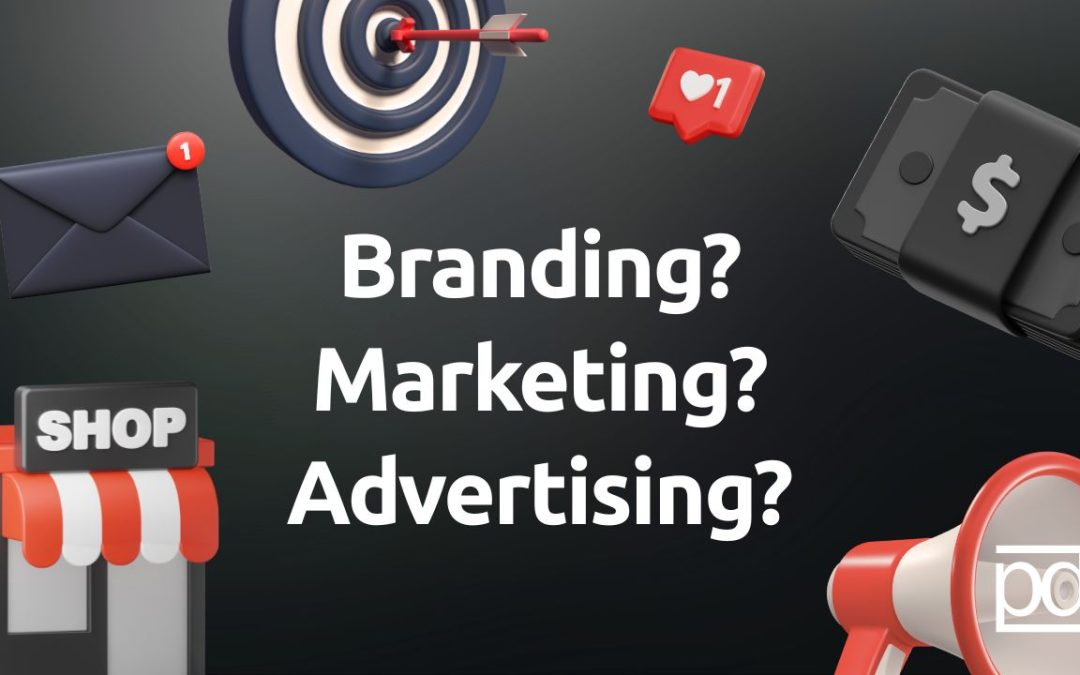If you’ve ever felt confused by the terms “branding,” “marketing,” and “advertising,” you’re not alone. These words get thrown around a lot, and often interchangeably, but they each play a distinct role in how your business connects with customers.
Let’s break it all down in plain English. By the end of this post, you’ll understand how these three concepts work individually and how they come together to build a powerful business presence.
Branding: Who You Are
Branding is the soul of your business. It’s not just your logo, tagline, or color scheme – it’s how people feel about your business. It’s what sets you apart from the competition and what makes people say, “I trust this company.”
Think of branding as your reputation, purpose, and personality rolled into one. It includes:
- Your mission and values
- Your tone of voice
- Your visual identity (logo, fonts, colors)
- The experience you deliver to customers
- How you make people feel
A strong brand is consistent across every touchpoint, from your website to your customer service. It’s what turns a one-time buyer into a loyal fan. For example, Apple isn’t just a tech company – its brand stands for innovation, simplicity, and premium design. That’s branding in action. Simply put, think of branding as the foundation. It’s what makes people recognize and connect with your business.
Marketing: How You Communicate
Marketing is the act of getting your brand out into the world – how you spread the word about your brand and offerings. It’s how you connect with potential customers, communicate your value, and create awareness. It’s the strategy behind getting your business in front of the right people.
Marketing is strategic. It asks:
- Who is our audience?
- Where do they spend time?
- What problems do they have?
- How can we show them we’re the solution?
Your marketing toolkit might include:
- Marketing strategy and research
- Search engine optimization (SEO)
- Social media management and campaigns
- Blog content and content creation
- Email marketing and newsletters
- Events, promotions, and partnerships
- Website messaging and funnels
In short, marketing is the game plan for spreading your message. It’s how people discover you, get to know you, and begin to trust you. Good marketing pulls people in and keeps them interested. It’s important to note that marketing is ongoing – it educates, builds interest, and nurtures potential customers.
Advertising: How You Promote
Advertising is a subset of marketing. It’s the paid, promotional side of the equation – designed to grab attention fast and drive specific actions. Essentially it’s the part of marketing where you pay to promote a message or offer – it’s direct and short term.
Advertising includes:
- Google Ads and pay-per-click (PPC) campaigns
- Paid social media ads on platforms like Facebook, Instagram, or LinkedIn
- Traditional media like print, radio, and TV
- Sponsored content and influencer collaborations
Unlike organic marketing, advertising is usually short-term and transactional: “Buy now,” “Click here,” “Limited-time offer.” It’s great for launching new products, reaching new audiences, or boosting sales during a promotion.
Think of advertising as turning up the volume on your marketing – it amplifies your message, but only works well if your brand and marketing foundation are solid.
How They Work Together
Here’s a simple analogy:
- Branding is who you are.
- Marketing is how you tell your story.
- Advertising is how you spread that story – fast and far.
You need all three to build a successful business. Without branding, your marketing lacks direction. Without marketing, your advertising feels random. And without advertising, your message might not reach as far as it could.
Let’s say you open a new coffee shop:
- Your brand is cozy, creative, and community-focused. You use earth tones, handwritten fonts, and always greet customers by name.
- Your marketing strategy includes local SEO, Instagram posts of your latte art, a blog about sustainable coffee, and email updates for your loyalty members.
- Your advertising might include a paid ad campaign on Facebook offering “Buy 1 Get 1 Free” for first-time visitors, or Google Ads targeting “coffee near me.”
Each element supports the other. That’s when the magic happens!
The Bottom Line
- Branding makes people care.
- Marketing helps them find you.
- Advertising nudges them to act (now).
Understanding the difference between these three, and how to use them together, helps you make smarter decisions about where to invest your time and budget. They work best together, and when aligned, they build trust and grow your business.
If you’re building a new business or trying to grow your presence, start with your brand. Get clear on who you are and what you stand for. Then craft a marketing strategy that tells that story well. And when you’re ready to reach a bigger audience, turn up the volume with advertising.
Need help aligning your branding, marketing, and advertising? Let’s talk about a strategy that works for your goals and your budget – fill out a questionnaire today.

